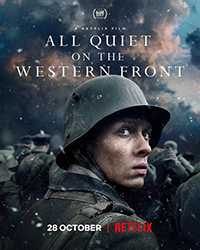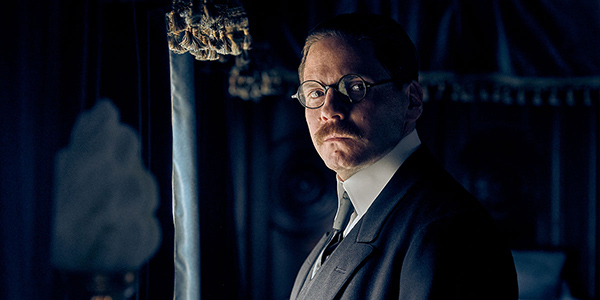War is Hell: Germany’s Oscar Entry Delivers Blunt & Brutal Depiction of WWI
 The most haunting image in filmmaker Edward Berger’s latest take on All Quiet on the Western Front has nothing to do with blood, bullets, or limbs torn from their bodies. It’s a small pile of name tags littered on the floor, ripped from the collar of military jackets, as they’re passed on to be worn by the next wave of faceless young soldiers waiting to be served up as cannon fodder on the front lines of WWI. The quiet scene is an exception as Germany’s meticulously mounted and brutally violent Oscar entry centers on the visceral and grisly marrow of the Great War. And while it’s an accomplished effort, the film struggles to offer any distinction from cinema’s long line of equally detailed pictures about the human cost of endless conflict.
The most haunting image in filmmaker Edward Berger’s latest take on All Quiet on the Western Front has nothing to do with blood, bullets, or limbs torn from their bodies. It’s a small pile of name tags littered on the floor, ripped from the collar of military jackets, as they’re passed on to be worn by the next wave of faceless young soldiers waiting to be served up as cannon fodder on the front lines of WWI. The quiet scene is an exception as Germany’s meticulously mounted and brutally violent Oscar entry centers on the visceral and grisly marrow of the Great War. And while it’s an accomplished effort, the film struggles to offer any distinction from cinema’s long line of equally detailed pictures about the human cost of endless conflict.
It’s 1917 and the war has been raging for three years. Paul Bäumer (Felix Kammerer) and his young friends rush to enlist, eager to prove themselves worthy of the mantle of Iron Youth, the moniker for the nation’s strong, resilient, and proud male adolescence. However, their spirited and playful eagerness at home as they excitedly don uniforms, train with weapons, and dream of leading their country to glorious victory quickly turns to horror the moment they hit the theater of war.
Under grey skies, they land near the front lines where the bodies of their countrymen lay in agony in a field hospital. Chaos reigns around them as they are steered into cold, muck-filled trenches. They’re ordered up and over into no man’s land where they watch the boys they grew up with get instantly shot and killed. As the film’s end title cards remind us, WWI was fought over patches of ground hundreds of yards wide, with either side hardly advancing their position across the course of war. That brutal futility marks the core of Berger’s film as Paul’s patchwork brotherhood becomes seasoned veterans of the battle simply by staying alive.
Contrasting the film’s unflinching look at boots squelching in mud, blades piercing skin, and blood pooling out of organs, are the political negotiations to end the war with Daniel Brühl’s Matthias Erzberger our surrogate into the back rooms and train cars of Germany’s high ranking officials. Here, sitting in plush chairs, and dining on sumptuous, multi-course meals, the discussion of war still speaks of high-minded ideals and saving face even as young soldiers are obliterated on numerous fronts throughout Europe. Keenly aware of the staggering loss of life, Matthias grimly and patiently tries to guide political leadership toward a ceasefire, keeping in reserve the desperation he has for a quick ending, keenly aware of the stark reality that Germany has lost. It’s a position that has yet to sink in for many of those around him.

Working with cinematographer James Friend, Berger excels at finding moments of cruel beauty in the film’s unending savagery. Misted blood mingles in the air with hanging gunsmoke, softly punctuating the film’s muted palette of steel grey, icy blue, and russet brown. The camera captures both the claustrophobic disorder of the trenches and the eerily quiet stretch of fields and forests just beyond the areas where young men are destroying each other to move an inch ahead. The score by Volker Bertelmann heavily underlines the fierceness of combat, with snares sounding off like rifle shots, and industrial-sized synths rolling like an unstoppable battalion of tanks. No stone is left unturned, suffering undocumented, or wound not opened to communicate the stench of death that is war.
Marking the third adaptation of Erich Maria Remarque’s 1928 novel following Lewis Milestone’s groundbreaking and Oscar-winning 1930 feature and Delbert Mann’s largely forgotten 1979 version, Berger’s is notably the first German interpretation of the German source material, and of course, the harrowing anti-war message appropriately takes center stage. But the looming question over the film is what it offers that the post-Saving Private Ryan era of war cinema hasn’t already. Steven Spielberg’s film — particularly its opening Omaha Beach sequence — will likely serve as a common comparison for Berger’s picture which offers an equally grim and realistic portrayal of battlefield barbarity.
For all its faithful wartime rendering and deeply moral storytelling, All Quiet on the Western Front has trouble sustaining its nearly two-and-a-half-hour runtime. Once it becomes apparent that Paul and his brethren can only outrun their fate for so long, the picture becomes deadening rather than moving. Perhaps it speaks to the cynicism of our current age, when contemporary conflicts play out on social media, that the nightmarish realities of trench warfare can seem antiquated. We get it — war is hell. So what next?
Reviewed on September 12th at the 2022 Toronto International Film Festival – Special Presentations. 147 Mins.
★★★/☆☆☆☆☆


